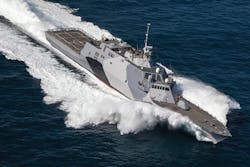Northrop Grumman eyes new Navy shipboard navigation to replace aging AN/WSN-7
WASHINGTON - U.S. Navy shipboard electronics experts are moving forward with a project to replace the aging AN/WSN-7 ring laser gyro for shipboard navigation with a new inertial sensor module to enable surface vessels to navigate accurately without GPS satellite navigation.
Officials of the Naval Sea Systems Command in Washington announced a $19.8 million contract to Northrop Grumman Corp. in Charlottesville, Va., to develop the Inertial Navigation Systems Replacement (INS-R) Inertial Sensor Module (ISM). The INS-R ISM will serve as the Navy's primary position source in the absence of a Global Positioning System (GPS). The INS-R will provide mission-critical ship positioning, velocity, and altitude data to shipboard sensors, combat systems, guns, and missile systems.
The contract calls for Northrop Grumman to develop and build the INS-R ISM, as well as to provide spare parts and technical support. The contract has options that could increase its value to $47.8 million. The company will provide engineering development models, pre-production units, low-rate initial production, and two years of full-rate production.
The INS-R will replace the AN/WSN-7 ring laser gyro navigation system, which uses 25-year-old technology based on the NATO MK49 inertial navigation system deployed in the late 1980s. The INS-R will provide improved real-time navigation for Navy surface warships, and enable future technology growth. An INS-R ship set will consist of two dual-redundant navigator units - one in the aft section and one in the forward section - that will operate independently of one another for survivability.
Northrop Grumman engineers will use an open-systems architecture using a modular design, standards-based interfaces, and standards to facilitate future technology insertion and technology refresh.
The contract calls for Northrop Grumman to use as many commercial off-the-shelf (COTS) components as possible in the INS-R ISM design.
On this contract Northrop Grumman will do the work in Charlottesville, Va.; Woodland Hills, Calif.; and Salt Lake City, and should be finished by November 2016.
FOR MORE INFORMATION visit Northrop Grumman at www.northropgrumman.com.

